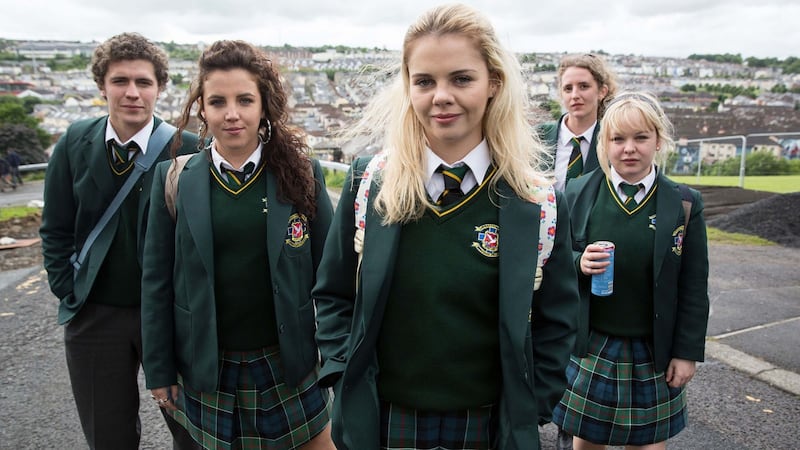It’s impossible to avoid the omnipresence of the 1990s in contemporary pop culture, fashion and media. The 1990s revival that had been threatened for so long has embedded itself in the mainstream, with a generation that was born post-2000 appropriating the cheesiness of the 1990s as contemporary cool, and those who grew up in it confused about the re-emergence of everything from tiny sunglasses to bleached-out hair, lo-fi rock and oversized logos.
Because nostalgia for the decade immediately preceding the one you’re currently in is jarring, the cheapest nostalgia tends to go back two decades. The most fertile ground for mining is 20 to 30 years ago. That’s also why a good deal of the 1990s vibe was in fact rooted in the 1970s; rock and roll, flares, postmodernism, heroin, mood rings, long hair, plaid and so on. And it’s also why 2018 looks and feels increasingly like the mid-1990s. The 1990s began 28 years ago, so reaching for its trends now is just like 1988 referencing 1960.
Recycled fashion
What’s familiar is comforting, and the window for nostalgia is constantly squeezed. For those who were teenagers in the 1990s, seeing your own crap fashion recycled by those a decade or so younger is disconcerting, but it also asks that lingering question about the 1990s: what were they about?
It’s difficult to consider an overarching characteristic when one thinks of the 1990s, compared with the decades that preceded it. The uncertainty about the 1990s’ place in history or in a grand cultural narrative feeds into a strange ambiguity of a decade that ended a century, despite the fact that perhaps no decade is influencing us more now than it. The rudderlessness of the 1990s bled into the 21st century. The following decades don’t even have proper names. “Noughties” is obviously terrible, and although the “aughts” has emerged as the most likely contender, the uncertainty over what to call that decade reflects a general confusion about the decade itself, a decade that turned out to be nothing like we expected, framed for many by 9/11 and financial failure, incidents we’re instructed to never forget while running away from a decade we don’t want to remember.
There is no truly cohesive analysis of the 1990s, no linear narrative, and maybe that's why we keep coming back to it, to try and make sense of it
Decades have a strange dialogue with each other. And right now, the latter stages of the 2010s are very much stuck in a 1990s mode. For me, the 1990s is a sort of a collage, a scattershot catch-all of pop, brands and multiculturalism. Indeed, actual collage is dominant throughout the decade, where imagery and styles were mashed together in everything from busy MTV graphics to the grunge aesthetic. This collage echo can be heard now, re-emerging as digital collage, and in the digital mood boards we create of ourselves to portray personality, and the intentionally disjointed graphic design style that has reached a point of parody.
Homogenised consumerism
Right now, television apes 1990s American independent cinema, washed-out pink, blue and neon hair is everywhere, athleisure reigns, zines are re-emerging, football scarves are having a fashion moment jostling for space among the oversized Calvin Klein and Tommy Hilfiger logos, Balenciaga is being praised for its grungey layering, the poles of drug culture remain ecstasy and opiates, gentrification continues apace, consumerism is increasingly homogenised, 1990s stars such as Ru Paul, George Clooney, Victoria Beckham, and Ellen are bigger than ever, makeup is reneging from peak-contouring and returning to simple, almost early-teen-like simplicity, Lady Bird and Derry Girls are the film and television hits, there's a penchant for ironic, old-school web design and there is, of course, a new kind of internet bubble, and a new kind of far-right terror, and the internet which changed media irreparably in the 1990s continues to change our identities and societies and discourse in dramatic ways, the 24-hour news cycle created by constant news has morphed into an hourly cycle of reaction, comment and memes, and the discourse surrounding LGBT communities now also has its roots in the increased visibility of particularly gay men in the 1990s, due to the HIV/AIDS global disaster, which continues to be erased in terms of its impact on culture and society. In many ways, maybe the 1990s never ended at all.

Perhaps decades truly become defined only by their revivals. There is no truly cohesive analysis of the 1990s, no linear narrative, and maybe that’s why we keep coming back to it, to try and make sense of it. What we dredge up when the time has passed is instructive. What were they really about? What do we decide to keep? What do we want back? In pop culture terms, what was interesting about the 1990s was how subculture and edginess became completely mainstreamed, and the biggest stars of the decade were often very unlikely ones, cool ones; Kurt Cobain, Kate Moss, Tracey Emin, River Phoenix, Tupac Shakur and the Notorious B.I.G. The anti-cool mainstream of the 2010s, typified by the term “basic”, has seen an absence of edge across popular culture, with image-based social media often gravitating towards twee niceness. Perhaps that’s another reason why the 1990s, where griminess coexisted alongside shininess, is so alluring. As authenticity fades, we’re returning to try and grasp at something that felt real.












